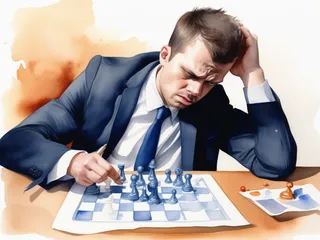A few years ago, I was having coffee with a former colleague who seemed unusually calm for someone juggling a demanding tech role, side projects, and family responsibilities. When I asked how he managed it all, he said something that stuck with me: "I stopped trying to optimize individual problems and started optimizing my decision-making process."
That conversation planted the seed for what became a fundamental shift in how I approach life. The transformation from reactive to strategic living isn't dramatic — it's more like refactoring messy code into clean, maintainable architecture. The functionality remains the same, but everything becomes more predictable and easier to work with.
What Strategic Living Actually Looks Like
Strategic living isn't about having your entire life mapped out in a detailed project plan. It's about developing consistent patterns of thinking and decision-making that compound over time.
Here's what changed for me:
Before: I'd accept every interesting project that came my way, then stress about managing competing priorities and deadlines.
After: I evaluate opportunities against clear criteria: Does this build skills I want to develop? Does it align with my career direction? Do I have the bandwidth to do it well? Most importantly, I say no to good opportunities that don't fit my strategic priorities.
Before: I'd learn new technologies reactively — whatever was needed for my current project or whatever seemed hot on developer Twitter.
After: I maintain a strategic learning portfolio: core skills that transfer across contexts, domain expertise that aligns with my career goals, and exploratory learning for future optionality.
Before: I'd network sporadically, usually when I needed something specific like job references or technical advice.
After: I invest consistently in relationships across different functions and experience levels, contributing value before I need anything in return.
The Daily Experience of Strategic Living
The most noticeable change isn't in major life decisions — it's in the dozens of small choices you make every day.
When someone asks you to take on additional work, instead of defaulting to "sure" or "I'm too busy," you evaluate it against your strategic priorities. This makes both yes and no decisions easier and more confident.
When you're deciding how to spend your evening, instead of mindlessly scrolling or binge-watching whatever's convenient, you might ask: "What would be most valuable right now — rest, learning, relationship building, or creative work?"
When you encounter a problem at work, instead of immediately jumping to solutions, you pause to understand the system that created the problem and address root causes rather than symptoms.
The Mental Shift: From Reactive to Proactive
The biggest transformation is psychological. Strategic living gives you a sense of agency and direction that's hard to describe if you haven't experienced it.
Before: Decision Fatigue and Analysis Paralysis
Without clear priorities and frameworks, every decision feels equally important and overwhelming. Should I take this job offer? Should I learn React or Vue? Should I move to a different city? Each choice requires starting from scratch, weighing pros and cons without clear criteria.
I used to spend enormous mental energy on decisions that, in retrospect, didn't matter much. The cognitive load of constantly making decisions without frameworks was exhausting.
After: Clarity and Confidence
With strategic frameworks in place, most decisions become straightforward. You evaluate options against your established criteria and values. This doesn't guarantee perfect outcomes, but it eliminates the paralysis and second-guessing that used to consume so much mental bandwidth.
More importantly, you stop agonizing over decisions that don't align with your strategic direction. It's easier to say no to opportunities that don't fit, even if they're objectively good opportunities.
Practical Examples of Strategic Transformation
Career Development
Reactive approach: Apply for jobs when frustrated with current role. Accept offers based primarily on salary increases or company prestige.
Strategic approach: Continuously build relationships and skills that align with career direction. Evaluate opportunities based on learning potential, cultural fit, and strategic positioning for future goals.
I stopped chasing every job opening that offered more money and started being more selective about roles that would teach me skills I wanted to develop. This led to better career progression and job satisfaction.
Skill Development
Reactive approach: Learn whatever's needed for immediate projects or whatever's trending in the industry.
Strategic approach: Maintain a balanced portfolio of skills — some deep expertise, some broad capabilities, and some experimental learning for future optionality.
Instead of jumping between frameworks based on what was popular, I focused on fundamental concepts that transfer across technologies and then went deep in areas that aligned with my career goals.
Time and Energy Management
Reactive approach: Say yes to requests by default. Plan activities based on availability rather than priorities.
Strategic approach: Protect time for strategic priorities. Make choices based on energy levels and long-term goals rather than just immediate demands.
I started treating my time and energy as finite resources that needed strategic allocation rather than just responding to whatever seemed urgent.
The Compound Effect Over Time
The benefits of strategic living compound in ways that aren't immediately obvious.
Better Decision Quality
When you consistently apply strategic frameworks to decisions, you develop better judgment over time. You start recognizing patterns and making faster, more accurate assessments of opportunities and risks.
Reduced Mental Overhead
Strategic living reduces the cognitive load of decision-making. Instead of reinventing your evaluation process for every choice, you apply consistent frameworks. This frees up mental bandwidth for creative and analytical work.
Increased Optionality
Strategic choices typically increase your future options rather than limiting them. By building transferable skills, diverse relationships, and financial stability, you create more choices for yourself over time.
Greater Resilience
When you understand your priorities and have systems for decision-making, you're more adaptable to unexpected changes. Strategic living doesn't prevent surprises, but it gives you better tools for responding to them.
Common Misconceptions About the Transformation
"It's Too Rigid"
Strategic living actually increases flexibility by giving you clear criteria for making trade-offs. When priorities are explicit, it's easier to adapt tactics while maintaining direction.
"It Takes Too Long to Show Results"
Some benefits are immediate — reduced decision fatigue and increased confidence in choices. Other benefits compound over months and years. The key is consistency rather than perfection.
"It's Only for Major Life Changes"
Strategic thinking applies to small decisions too. How you spend your learning time, which projects you volunteer for, even which conferences you attend — these choices compound over time.
The Ongoing Practice
Strategic living isn't a destination — it's a practice that evolves as you do. Your priorities will shift, your circumstances will change, and your frameworks will need updating.
I do quarterly reviews where I assess what's working, what isn't, and what adjustments make sense. This isn't about judging past decisions but about learning from experience and refining my approach.
Building the Habit
Start small. Pick one area of your life where you make frequent decisions — maybe how you spend learning time or which social events you attend. Develop simple criteria for those choices and practice applying them consistently.
As strategic thinking becomes more natural, expand to bigger decisions. The goal is building the mental muscle of strategic evaluation, not creating perfect frameworks immediately.
The Long-Term Vision
Strategic living is ultimately about taking ownership of your life's architecture. Instead of letting circumstances and other people's priorities determine your path, you become the intentional designer of your own experience.
This doesn't mean you control outcomes — there's still plenty of uncertainty and chance involved. But you significantly increase the probability of creating the kind of life and career you actually want rather than just accepting whatever emerges from reactive decision-making.
The transformation from chaos to clarity isn't dramatic, but it's profound. You move from feeling like life is happening to you to feeling like you're actively shaping it. That shift in perspective changes everything.





